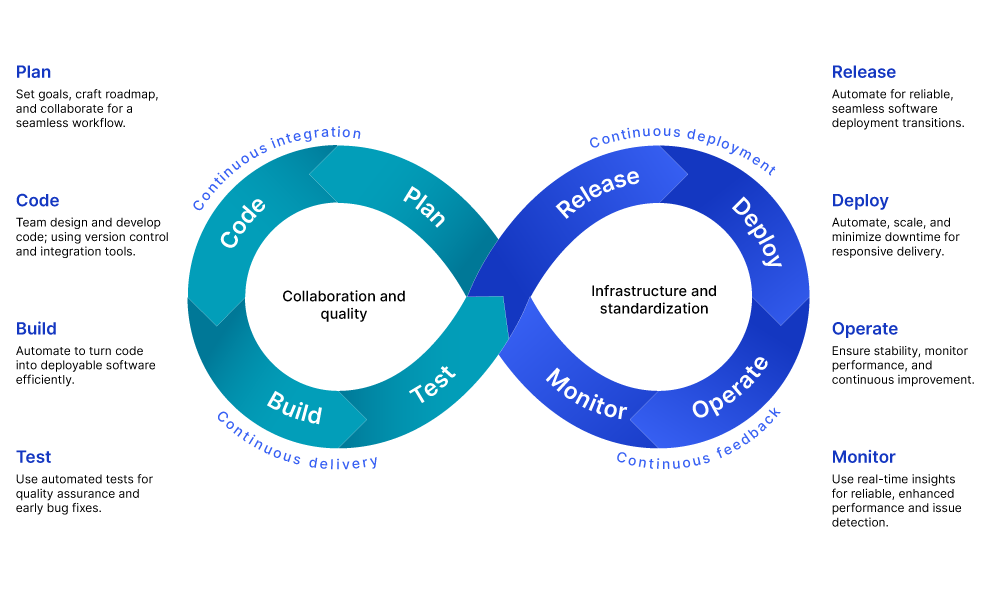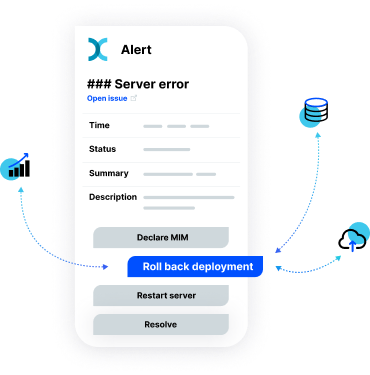What is a DevOps Toolchain and How Does it Work?

Imagine tackling a code error only to discover an even more complex issue beyond your expertise. You need to contact the right people quickly to avoid system downtime, but what if they’re unavailable or you’re unsure who to reach?
Instead of trying to solve the problem without proper support, a DevOps Toolchain could have mitigated this incident from the start.
Relying on outdated communications and collaboration methods can turn minor issues into major disruptions.
A DevOps Toolchain integrates tools to automate tasks, streamline development, and maintain systems, allowing you to focus on higher-value work.
What is a DevOps Toolchain?
A DevOps toolchain is a set of interconnected tools designed to streamline and automate software development and operations processes.
It facilitates collaboration by integrating tools supporting coding, building, testing, deployment, version control, monitoring tasks, and incident/issue response. By automating these tasks, the DevOps Toolchain helps ensure the continuous delivery of software and services, minimizing the need for manual intervention.
Whether pre-configured or custom-built, toolchains enhance productivity and reliability, allowing DevOps practitioners and SREs to manage even the most complex environments smoothly.
Why Do We Need DevOps Toolchains?
The need to stay reliable and competitive drives organizations to adopt DevOps principles, emphasizing speed, collaboration, and automation.
The rapid evolution of digital technology and increasing demand for quicker software delivery cycles have made the DevOps Toolchain crucial.
A DevOps Toolchain facilitates software and infrastructure development, delivery, and optimization. Historically, DevOps organizations have brought excellent automation to the continuous integration, delivery (CI/CD), and continuous development process or pipeline, but the automation ended with “deployment.” As incidents arose, responding was largely a manual process after monitoring or observability alerts flagged an issue.
If your organization requires more than one person to manage an incident, from initial alert to final resolution, an expanded DevOps Toolchain with incident response automation significantly reduces time to mitigation, bringing automation to this important feedback loop.
The key drivers behind the DevOps Toolchain’s critical role in modern software development and operational success include:
-
Accelerated Development Cycles
DevOps Toolchains automate many manual processes. It enables teams to streamline development workflows and celebrate product releases without sacrificing quality.
By connecting coding, testing, and deployment tools into a unified system, software can move from development to production much faster.
-
Enhanced Collaboration and Communication
DevOps Toolchains foster better communication between development and operation teams by providing a shared set of tools that integrate various workflows. This alignment reduces silos and helps everyone stay on the same page.
Suppose your organization requires manual handling and multiple team members to manage an incident, from initial alert to final resolution. In that case, incident management software can enhance collaboration, helping teams respond to issues more quickly and maintain systems uptime. -
Increased Deployment Frequency
The automation capabilities within DevOps Toolchains allow for frequent and reliable software deployments, reducing the risk of errors and improving overall agility.
With continuous integration and delivery (CI/CD) pipelines, you can deploy new features, bug fixes, and updates more often, staying competitive in an ever-evolving market. -
Improved Quality and Reliability
By automating testing and monitoring, DevOps Toolchains help maintain high standards of quality and reliability. Automated checks ensure that only stable, high-performing software reaches production, reducing the likelihood of downtime or system failures.
The toolchain also facilitates continuous monitoring, allowing teams to detect and resolve issues in real-time. -
Reduce problem mitigation time or Faster mean time to repair (MTTR)
The toolchain also facilitates continuous monitoring, allowing teams to detect, respond, and resolve issues in real-time. Leverage alerts from real-time observability to identify and act on patterns, correlated events, and performance data.
The ultimate goal would be to trigger automated remediation. However, most organizations have not grown to a level of maturity to drive this, so Engagement and Action steps are the most practical automation.
The engagement phase involves human experts resolving issues and reducing reliance on traditional IT metrics and alerts. The system generates personalized, real-time alerts for the appropriate teams, both preemptively and during incidents.
In the action phase, AIOps technologies help improve and maintain IT infrastructure. The long-term aim is to automate operational processes, allowing teams to focus on mission-critical tasks.
IT teams can create automated responses based on insights from machine learning algorithms, deploying systems that learn from past events to preempt similar issues. For example, AI can automatically inspect code, ensuring issues are resolved before software updates are released to affected customers.
How DevOps Toolchains Work

Each stage of the toolchain works cohesively to support the development process, from planning to deployment, ultimately ensuring a more efficient, reliable, and scalable workflow. But how exactly does it do that?
Here’s a step-by-step breakdown of a typical DevOps cycle illustrating how these tools work together:
Planning and Coding
The cycle starts with defining project goals and writing the initial code. Collaboration tools, version control systems, and issue-tracking software keep teams aligned, facilitating project management and progress tracking.
Building and Testing
Continuous integration (CI) tools automate compiling and building code in this phase. These tools run tests to detect bugs early, ensuring new code integrates smoothly with existing systems without manual intervention.
Integration and Deployment
Now, the code moves to continuous delivery (CD) pipelines, which automate the deployment of updates to production environments, reducing human error and speeding up the delivery cycles. This stage ensures seamless and reliable software releases with minimal downtime.
Monitoring and Optimization
Once the software is live, monitoring tools can track system performance and user behavior in real-time. These tools can also analyze the data and recommend improvements for future updates.
With incident management analytics tools, you can continuously gain visibility on team performance, response efficacy, and real-time incident details.
How to Efficiently Build a DevOps Toolchain
Building a DevOps Toolchain tailored to your organization’s needs can involve several steps:
-
Assess Your Current Infrastructure and Processes
Evaluate existing workflows and pinpoint areas where automation could alleviate bottlenecks or speed/eliminate manual tasks. Understanding the current state of your operations is critical for identifying the right tools.
-
Identify Essential Tools for Automation
Choose tools that complement each other and integrate well into your existing environment. You can prioritize tools that enhance collaboration between your developers and operations teams if that’s what your teams need the most.
For example, with Infrastructure-as-Code (IaC) implementation, organizations can manage infrastructure through code, automating configuration and deployment. This increases consistency and reduces the risk of human error during setup.
-
Integrate and Streamline Your Toolchain
Ensure that your chosen tools are compatible and communicate effectively. Toolchains should be capable of automatically executing tasks, from code testing to deployment, as well as responding to alerts/issues/incidents, with minimal manual intervention.
If you need to deploy multiple updates daily, you can benefit from CI/CD pipelines. DevOps Toolchains automate the testing and release processes, ensuring that updates are deployed without introducing errors or disruptions to the system.
Automating more of your incident response reduces toil for DevOps engineers while ensuring your business runs more smoothly with fewer interruptions and potentially avoids impacts to business users.
-
Adapt to Evolving Needs and Technologies
The landscape of DevOps tools is continually evolving. Periodically assess whether your toolchain meets organizational needs and adopt new tools or updates to enhance functionality.
For example, multiple teams may start working on different software product components if your organization scales. A DevOps Toolchain ensures each team’s work is aligned by providing integrated tools to promote seamless communication and collaboration.
-
Implement Continuous Evaluation and Optimization
Regularly evaluate the performance of your DevOps Toolchain to ensure it remains effective. This includes monitoring how well tools integrate and the speed and reliability of the development process.
Integrating monitoring tools allows you to track system performance and continuously gather feedback for future improvements. The DevOps Toolchain enables real-time incident visibility, helping teams proactively manage and resolve issues.
DevOps Toolchain Use Case
DevOps Toolchains are widely used across various industries to enhance efficiency and collaboration. Here is an example of how implementing these toolchains solves specific challenges:

Imagine you received a notification on the xMatters mobile app that a vendor type has identified a potential major incident impacting a critical Service. Directly from that notification, you can start your DevOps Toolchain and seamlessly begin the automated remediation steps aligned to the impacted service. The process may look something like this:
A DevOps Toolchain can automatically work through remediation steps.
- Your response to the notification can open a ServiceNow ticket and create a new Slack channel automatically. Automated steps add critical information to the Slack channel without manual input.
- From there, you can easily invite the most appropriate and available team members to the Slack channel by integrating your on-call scheduling tool.
- The incident commander can then use slash commands within Slack to open a Jira issue and publish a status page notice for customers.
- Once the incident is resolved, automated steps can gather the Slack chat and post it to the ServiceNow incident Notes to ensure you have a complete audit trail.
With a DevOps Toolchain in place, you can open a service ticket, communicate vital information with the right team members, open an issue in your project management tool, and create a platform to communicate the incident with your customers.
Instead of spending time manually acting upon those individual tasks, the toolchain can take care of them while you prioritize resolving the incident. By automating these tasks and streamlining workflows, you not only resolve incidents faster but also contribute to long-term improvements in your software development process.
Enhance Software Development, Delivery, and Optimization
A DevOps Toolchain is essential for improving productivity, automating tasks, and ensuring the continuous delivery of software.
Whether you’re implementing a simple toolset or a comprehensive solution, adopting a well-structured DevOps Toolchain is a strategic investment in the long-term success of your organization.
Bridge the gap between various stages of the DevOps cycle by leveraging advanced incident management software solutions and real-time collaboration tools.
Everbridge xMatters automates workflows to eliminate digital events, leveraging analytics, automation, and AI to improve response time and resolution. We transform your organization’s approach to DevOps.
Get started today by exploring how Everbridge xMatters can simplify your DevOps processes. Request a demo, and we’ll show you how to:
- Build and modify workflows with drag-and-drop simplicity
- Develop with low/no-code tools
- Leverage AI and automation to improve response times
- Automate responses all the way to the resolution
- Adapt quickly to changing needs and situations
Learn how to implement a toolchain that fits your organization’s unique needs and enhances your DevOps practices with us.
